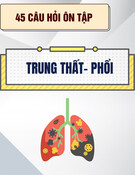
TẠP CHÍ Y häc viÖt nam tẬP 547 - th¸ng 2 - sè 1 - 2025
301
Practice & Research Clinical Anaesthesiology. 2020;
34(3):427-448. doi: 10.1016/ j.bpa.2020.08.003
4. Walker JW, Shah BJ. Trigger point injections: a
systematic, narrative review of the current
literature. SN Comprehensive Clinical Medicine.
2020;2(6):746-752. doi:10.1007/s42399-020-00286-0
5. Schnitzler A, Roche N, Denormandie P,
Lautridou C, Parratte B, Genet F. Manual
needle placement: accuracy of botulinum toxin A
injections. Muscle & nerve. 2012; 46(4):531-534.
doi: 10.1002/mus.23410
6. Xie P, Qin B, Yang F, et al. Lidocaine injection
in the intramuscular innervation zone can
effectively treat chronic neck pain caused by
MTrPs in the trapezius muscle. Pain Physician.
2015; 18(5):E815.
7. Bae J-H, Lee J-S, Choi D-Y, Suhk J, Kim ST.
Accessory nerve distribution for aesthetic
botulinum toxin injections into the upper trapezius
muscle: anatomical study and clinical trial:
reproducible BoNT injection sites for upper
trapezius. Surgical and Radiologic Anatomy. 2018;
40:1253-1259. doi: 10.1007/s00276-018-2059-4
8. Gavid M, Mayaud A, Timochenko A, Asanau
A, Prades J. Topographical and functional
anatomy of trapezius muscle innervation by spinal
accessory nerve and C2 to C4 nerves of cervical
plexus. Surgical and Radiologic Anatomy. 2016;
38:917-922. doi: 10.1007/s00276-016-1658-1
9. Wang J-W, Zhang W-B, Li F, et al. Anatomy
and clinical application of suprascapular nerve to
accessory nerve transfer. World Journal of Clinical
Cases. 2022; 10(27):9628.
doi: 10.12998/wjcc.v10.i27.9628
10. Barbero M, Cescon C, Tettamanti A, et al.
Myofascial trigger points and innervation zone
locations in upper trapezius muscles. BMC
musculoskeletal disorders. 2013; 14:1-9.
doi: 10.1186/1471-2474-14-179
ĐÁNH GIÁ HIỆU QUẢ ĐIỀU TRỊ ĐAU ĐẦU NGÓN TAY BẰNG TIÊM
BOTULINUM TOXIN TYPE A Ở NGƯỜI BỆNH XƠ CỨNG BÌ CÓ HIỆN
TƯỢNG RAYNAUD TẠI BỆNH VIỆN ĐA KHOA TỈNH THANH HÓA
Nguyễn Văn Hồng Quân1,2, Hoàng Thị Ngọ2, Lê Thị Minh Trang2
TÓM TẮT73
Mục tiêu: Đánh giá hiệu quả điều trị hiện tượng
Raynaud ở người bệnh xơ cứng bì bằng botulinum
toxin type A (BTA) ở bệnh viện Đa khoa tỉnh Thanh
Hóa. Phương pháp nghiên cứu: Mô tả cắt ngang,
lựa chọn các bệnh nhân được điều trị bằng BTA, một
bàn tay được tiêm BTA trước và bàn tay còn lại được
tiêm sau 1 tháng; nghiên cứu so sánh hiệu quả điều
trị ở tay được tiêm và tay chưa được tiêm ngay trước
thời điểm bàn tay thứ 2 được tiêm. Kết quả: Có 30
bệnh nhân được điều trị bằng BTA. Sau 4 tuần từ lúc
tiêm BTA ở tay không thuận, điểm đau VAS ở tay
không thuận giảm trung bình 0,60±0,86 (p<0,001),
điểm VAS ở tay thuận giảm 0,17±0,79 (p=0,258);
nhiệt độ đầu ngón tay trung bình của nhóm bàn tay
được tiêm BTA tăng thêm 1,28±0,77oC (p<0,001),
không có sự thay đổi về nhiệt độ nền ở nhóm không
được tiêm (p=0,217); ở nhóm bàn tay được tiêm BTA,
biến thiên nhiệt độ sau kích thích lạnh đã tăng từ
2,43±0,58oC lên 4,15±1,11oC (p<0,001), ở nhóm bàn
tay chưa được tiêm không có khác biệt sau 4 tuần
(p=0,241). Không ghi nhận các tác dụng phụ nghiêm
trọng như nhiễm trùng, chảy máu, yếu cơ, dị ứng. Kết
luận: Phương pháp tiêm BTA tại chỗ có thể có hiệu
quả và an toàn để điều trị hiện tượng Raynaud ở
1Phân hiệu trường Đại học Y Hà Nội tại tỉnh Thanh Hóa
2Bệnh viện Đa khoa tỉnh Thanh Hóa
Chịu trách nhiệm chính: Nguyễn Văn Hồng Quân
Email: nguyenvanhongquan@hmu.edu.vn
Ngày nhận bài: 20.11.2024
Ngày phản biện khoa học: 20.12.2024
Ngày duyệt bài: 22.01.2025
người bệnh xơ cứng bì.
Từ khóa:
Raynaud, Botulinum, xơ cứng bì
SUMMARY
EVALUATION OF THE EFFECTIVENESS OF
TREATING FINGERTIP PAIN BY
BOTULINUM TOXIN TYPE A IN PATIENTS
WITH SLEERODERMA WITH RAYNAUD'S
PHENOMENON AT THANH HOA
PROVINCIAL GENERAL HOSPITAL
Objective: To evaluate the effectiveness of
treating Raynaud's phenomenon in patients with
scleroderma with botulinum toxin type A (BTA) at
Thanh Hoa General Hospital. Research method:
cross-sectional, selecting patients treated with BTA,
one hand was injected with BTA first and the other
hand was injected after 1 month; the study compared
the treatment effectiveness in the injected hand and
the hand that had not been injected immediately
before the second hand was injected. Results: 30
patients were treated with BTA. After 4 weeks from
BTA injection in the non-dominant hand, the VAS pain
score in the non-dominant hand decreased by an
average of 0.60±0.86 (p<0.001), the VAS score in the
dominant hand decreased by 0.17±0.79 (p=0.258);
The average fingertip temperature of the BTA-injected
hand group increased by 1.28±0.77oC (p<0.001),
there was no change in the baseline temperature in
the non-injected group (p=0.217); in the BTA-injected
hand group, the temperature variation after cold
stimulation increased from 2.43±0.58oC to
4.15±1.11oC (p<0.001), in the uninjected hand group
there was no difference after 4 weeks (p=0.241). No
serious side effects such as infection, bleeding, muscle






























